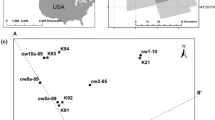Abstract
The advective flow of sediment pore water is an important parameter for understanding natural geochemical processes within lake, river, wetland, and marine sediments and also for properly designing permeable remedial sediment caps placed over contaminated sediments. Automated heat pulse seepage meters can be used to measure the vertical component of sediment pore water flow (i.e., vertical Darcy velocity); however, little information on meter calibration as a function of ambient water temperature exists in the literature. As a result, a method with associated equations for calibrating a heat pulse seepage meter as a function of ambient water temperature is fully described in this paper. Results of meter calibration over the temperature range 7.5 to 21.2 ° C indicate that errors in accuracy are significant if proper temperature-dependence calibration is not performed. The proposed calibration method allows for temperature corrections to be made automatically in the field at any ambient water temperature. The significance of these corrections is discussed.











Similar content being viewed by others
References
Carslaw, H. S., & Jaeger, J. C. (1947). Conduction of heat in solids (1st ed.). London: Oxford University Press.
Hyun, S., Jafvert, C. T., Jenkinson, B., Enfield, C., & Johnson, B. (2007). Measuring the flux at the interface of coal-tar impacted sediment and river water near a former MGP site. Chemosphere, 68(6), 1020–1029.
Jafvert, C. T., Lane, D., Lee, L. S., & Rao, P. S. C. (2006). Partitioning of mono- and polycyclic aromatic hydrocarbons in a river sediment adjacent to a former manufactured gas plant site. Chemosphere, 62(2), 315–321.
Kalbus, E., Reinstorf, F., & Schirmer, M. (2006). Measuring methods for groundwater? Surface water interactions: a review. Hydrology and Earth System Sciences Discussions, 10(6), 873–887.
Kim, Y. S., Nyberg, L. M., Jenkinson, B., & Jafvert, C. T. (2013). PAH concentration gradients and fluxes through sand cap test cells installed in situ over river sediments containing coal tar. Environmental Science: Processes and Impacts, 15, 1601–1612.
Lee, D. R. (1977). A device for measuring seepage fluz in lakes and estuaries. Limnology and Oceanography, 22, 140–147.
Lien, B. K. (2006). Development and demonstration of a bidirectional advective flux meter for sediment-water interface (p. 45268). Cincinnati: National Risk Management Research laboratory.
Lien, B. K., & Enfield, C. (2010). Automated long-term remote monitoring of sediment-water interfacial flux. U.S. Environmental Protection Agency, Office of Research and Development, National Risk Management Research Laboratory, EPA/600/R-10/110.
Murdoch, L. C., & Kelly, S. E. (2003). Factors affecting the performance of conventional seepage meters. Water Resources Research, 39(6), 1163.
Mwashote, B., Burnett, W., Chanton, J., Santos, I., Dimova, N., & Swarzenski, P. (2010). Calibration and use of continuous heat-type automated seepage meters for submarine groundwater discharge measurements. Estuarine, Coastal and Shelf Science, 87(1), 1–10.
Paulsen, R. J., Smith, C. F., O’Rourke, D., & Wong, T. F. (2001). Development and evaluation of an ultrasonic ground water seepage meter. Ground Water, 39(6), 904–911.
Ren, T., Horton, R., & Kluitenberg, G. (2000). Determining soil water flux and pore water velocity by a heat pulse technique. Soil Science Society of America Journal, 64, 552–560.
Rosenberry, D. O., & Morin, R. H. (2004). Use of an electromagnetic seepage meter to investigate temporal variability in lake seepage. Ground Water, 42(1), 68–77.
Schincariol, R. A., & McNeil, J. D. (2002). Errors with small volume elastic seepage meter bags. Ground Water, 40, 649–651.
Sholkovitz, E., Herbold, C., & Charette, M. (2003). An automated dye-dilution based seepage meter for the time-series measurement of submarine groundwater discharge. Limnology and Oceanography: Methods, 1, 16–28.
Smith, A. J., Herne, D. E., & Turner, J. V. (2009). Wave effects on submarine groundwater seepage measurement. Advances in Water Resources, 32(6), 820–833.
Steinhart, J. S., & Hart, S. R. (1968). Calibration curves for thermistors. Deep-Sea Research, 15(4), 497–503.
Swarzenski, P. W., & Izbicki, J. A. (2009). Coastal groundwater dynamics off Santa Barbara, California: combining geochemical tracers, electromagnetic seepmeters, and electrical resistivity. Estuarine, Coastal and Shelf Science, 83(1), 77–89.
Taniguchi, M., & Fukuo, Y. (1993). Continuous measurements of ground‐water seepage using an automatic seepage meter. Ground Water, 31(4), 675–679.
Taniguchi, M., & Iwakawa, H. (2001). Measurements of submarine groundwater discharge rates by a continuous heat-type automated seepage meter in Osaka Bay, Japan. Journal of Groundwater Hydrology, 43(4), 271–278.
Taniguchi, M., Burnett, W. C., Smith, C. F., Paulsen, R. J., O’Rourke, D., Krupa, S. L., et al. (2003). Spatial and temporal distributions of submarine groundwater discharge rates obtained from various types of seepage meters at a site in the Northeastern Gulf of Mexico. Biogeochemistry, 66(1), 35–53.
Taniguchi, M., Burnett, W. C., Dulaiova, H., Kontar, E. A., Povinec, P. P., & Moore, W. S. (2006). Submarine groundwater discharge measured by seepage meters in Sicilian coastal waters. Continental Shelf Research, 26(7), 835–842.
Taniguchi, M., Ishitobi, T., Burnett, W. C., & Wattayakorn, G. (2007). Evaluating ground water–sea water interactions via resistivity and seepage meters. Ground Water, 45(6), 729–735.
Acknowledgments
This study was supported by Weston Solutions Inc., Purdue University, and The National Natural Science Foundation of China (Grant No.41301546). This project was also sponsored by the Major Science and Technology Program for Water Pollution Control and Treatment (Grant No. 2012ZX07101-008) of China.
Conflict of interest
The authors declare that they have no conflict of interest.
Author information
Authors and Affiliations
Corresponding author
Rights and permissions
About this article
Cite this article
Zhu, T., Fu, D., Jenkinson, B. et al. Calibration and application of an automated seepage meter for monitoring water flow across the sediment-water interface. Environ Monit Assess 187, 171 (2015). https://doi.org/10.1007/s10661-015-4388-7
Received:
Accepted:
Published:
DOI: https://doi.org/10.1007/s10661-015-4388-7




